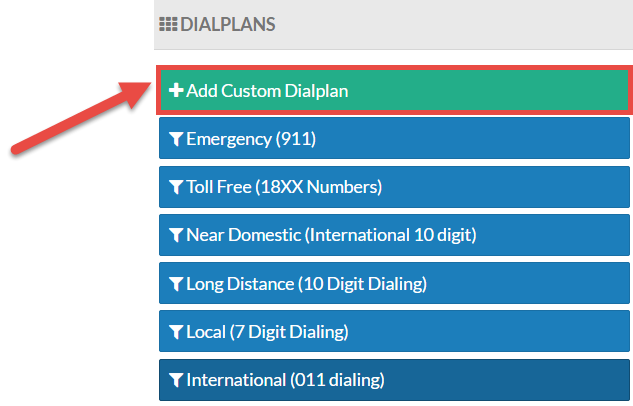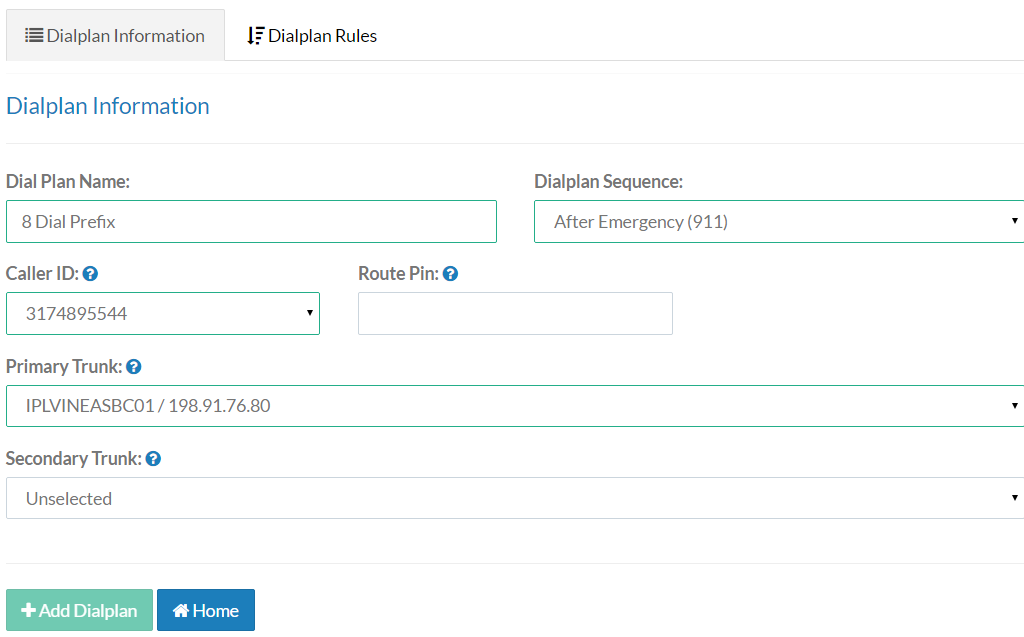Administrators are able to create their own custom dial plan logic to specify which trunk and caller ID are to be utilized when a certain dialing pattern is matched.
To create a new Custom Dial Plan, click the green +Add Custom Dialplan button on the main Dial Plans menu as shown in Figure 01 below.
 Figure 01: Add Custom Dial Plan
Figure 01: Add Custom Dial Plan
After clicking the +Add Custom Dialplan button, the Dialplan Information screen will display allowing the administrator to configure the new dialing pattern logic as well as set the desired trunk and caller ID information.
 Figure 02: Dialplan Information
Figure 02: Dialplan Information
Dial Plan Name: Enter an easily recognizable name for the dial plan. This is used for administrative purposes only.
Dial Plan Sequence: This field determines the order the dial plan will be built in the Dial Plan List. Dial plans near the top of the list are analyzed first, while lower dial plans are analyzed last. For example, a custom dialplan is built that uses the dialing plan rule 1-800-XXX-XXXX. If this new custom dial plan is placed in the sequence before the default "toll-free" dialing plan, then the custom dial plan will be successfully used. If the custom dial plan is set after the default toll-free dialing plan in the sequence, then the custom dial plan will not be used. This is because the dialing pattern will match the default toll-free dial plan first and the custom dial plan logic will not be reached because a match has already been found. When two dial plans use the same logic, the one that is first in the sequence will be used.
In most cases, it makes sense to set the Dial Plan Sequence for a custom dial plan as After Emergency (911) as it will ensure that the custom dial plan is used first.
| NOTE: | Emergency (911) must always be the first dial plan in the sequence. The system will always check if 911 is dialed first and then move on to lower custom and default dialing plans. |
Custom Dial Plan Rules
The Dialplan Rule is a set of digits and routing rules that determine if or when the custom dial plan should be used. If an extension dials a specific set of numbers that matches one of the dialplan rules, then the call will utilize the custom dial plan.
There are three fields on the Dialplan Rules menu: Prepend, Prefix, and Match Pattern.
Prepend: Digits entered into the Prepend field will be added at the beginning of a number when the dialed number successfully matches a Match Pattern. Upon a match, whatever value is entered as a "prepend" will be added to the dialed number before the call is sent to its end destination.
Prefix: The Prefix field is a value that is to be removed when a number successfully matches one of the Match Patterns. Upon a match, the value entered into this field is stripped from the dialed number before the call is sent to the end destination.
Match Pattern: When a number is dialed, Kerauno compares the digits dialed to the existing match patterns built into the phone system. If a match is found, then the call is sent to the matching dial plan. Below are the characters that can be used to create new patterns as well as examples of each.
X matches any digit from 0-9
Z matches any digit from 1-9
N matches any digit from 2-9
[1237·9] matches any digit in the brackets (e.g., 1,2,3,7,8,9)
Examples:
NXXXXXX - This pattern would match any seven-digit number starting with 2-9
1XXXXXXX - This pattern would match any seven-digit number dialed that is preceded by a 1.
888NXXXXXX - This pattern would match any toll free number that begins with 888 whose 4th digit is between 2-9.
2[0-5]XXXXXXXX - This pattern would match any 10-digit number with an area code of 200-250.
Dial Plan Rule Examples:
 Figure 03: Four Custom Prefix Match Patterns, Example 1
Figure 03: Four Custom Prefix Match Patterns, Example 1
This configuration would be useful if attempting to use dial plans to use a different caller ID or trunk when the calling party dials "7" before the number. All patterns have a prefix of 7.
- The first pattern listed will be matched if a caller dials 7, 1, and then any seven-digit number.
- The second pattern will be matched if a caller dials 7,1, and then any 10-digit number.
- The third pattern will be matched if a caller dials 7 and then any seven-digit number.
- The third pattern will be matched if a caller dials 7 and then any 10-digit number.
 Figure 04: Four Custom Match Patterns, Example 2
Figure 04: Four Custom Match Patterns, Example 2
This configuration would be useful if attempting to use dial plans to use a different caller ID or trunk when a specific number is dialed. In this case, 317-489-5544 is used.
- The first pattern listed will be matched if a caller dials 317-489-5544
- The second pattern will be matched if a caller dials 1-317-489-5544.
- If a caller dials 489-5544, a 317 area code will be prepended and the call will dial 317-489-5544.
- If a caller dials 1-489-5544, a 317 area code will be prepended and the call will dial 317-489-5544.
